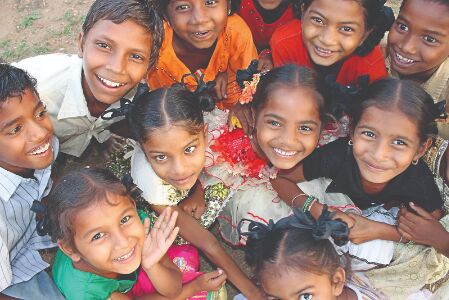Following the Lok Sabha tradition, the Union budget for the current year was presented by our Finance Minister, on the first of February and the 2022-23 budget comes to the people of India who have endured economic, social, and psychological distress for the past three years. Research from Azim Premji University reveals that Covid-19 has pushed 230 million Indians into poverty which has a direct impact on their nutrition, health, education, and overall well-being.
The current budget does not address these challenges and it is imperative that the human capability sectors require a considerate allocation of resources. But it’s also essential to go a step further and integrate the questions on accountability when the budget is debated. With this article, we raise questions on some key schemes which have a direct impact on children’s and youths’ well-being that showcases how the budget misses the mark.
Missing Status
- Nutrition
Though the allocation for the integrated nutrition schemes Saksham Anganwadi and Poshan 2.0 saw a 1% increase in the current budget, the share of children under Saksham Anganwadi and Poshan 2.0 was reduced to 11.28% (from INR 19412.5 Crores in 2020 to INR 17223.61 Crore in 2022)according to the budget analysis by Haq. The reason for the reduction in the backdrop of a pandemic could be an obvious question here, but how was the allocated amount utilized is equally significant. Research reveals that since the inception of Poshan Abhiyan in 2017, only 53% of the total allocated funds were released by the Union Government and, of that, only 56% was spent in the last 3 financial years.
Why were almost half of the allocated funds underspent in the past three years? What was the specific implementation challenge? Was it specific to any geographic area? Was it necessarily Covid-19 related challenges? What was the direct impact of this on children and young people of the country? It is appalling that these questions are not acknowledged nor addressed when we are presented with a new budget with significantly reduced allocation for child nutrition, where malnutrition levels are steadily rising.
- Child Protection
A look at child protection schemes reveals a similar trend. The Integrated Child Protection Scheme (ICPS) under the Ministry of Women and Child (meant to reduce vulnerabilities and improve the wellbeing of children in difficult circumstances) was allocated INR 1500 Crores in 2020. ICPS was subsumed under Mission Vatsalya in 2021 and in total the mission received only an allocation of INR 900 Crores. The final amount released under Mission Vatsalya in 2021 – a year that witnessed a serious increase in child protection issues such as child labor, trafficking, and child marriages was just 523 Crores.
Interestingly, this year Mission Vatsalya received an increase in allocation from INR 900 Crores to INR I472 Crores. But the question that remains unanswered is, what explains the underspending last year?
An examination of public policies and budget reveals that they hardly take stock of what has already been achieved and missed, and the reasons for it. Without a status report on the schemes, how can the general public make sense of what has been achieved and missed, what needs to be done and how much resource is required? Or understand why there has been a reduction or increase in funds for various schemes.
The counter–argument for this could be the RTI provision, but research reveals that many of the RTI applications do not receive prompt responses. Furthermore, sudden subsumptions, omissions and change in names of schemes also add another layer of complexity for individuals who want to follow up.
Missing Outcomes
- Education
Apart from the fact that many schemes do not have a status report on their performance, the newly proposed initiatives seem to be disconnected from policy goals and grassroots realities. For instance, the current budget makes allowances for new digital interventions in education, but because of the deep digital divide in the country, the proposed digital university in the budget will only be accessible to a minuscule population of students, as reports show that almost 60% of school children are unable to access online learning. While the NEP pushes for learning outcomes and foundational literacy and numeracy, the current budget has reduced its allocation for teacher training and adult education considerably (from Rs 250 crore in 2021-22 to Rs 127 crore in 2022-23). What also is confusing is, despite a push towards digital learning, the actual allocation of e-learning program, which includes the PM e-Vidya scheme, has been reduced to Rs 421.01 crore in 2022-23 from Rs 645.61 crore in 2021-22.
Another anomaly in this year’s budget is the budgetary cuts for schemes meant for girls from deprived communities. A report by the National Campaign for Dalit Human Rights and Dalit Arthik Adhikar Andolan (NCDHR-DAAA) reveals that 51% of Dalit and Adivasi students have been unable to access online classes and 46% did not receive scholarships amounts on time in the last year. The Post-matric Scholarship which helps oppressed communities to access higher education has also seen a fall in allocation this year. While students from the oppressed communities have been impacted disproportionately because of the pandemic, the dissolution of the National Scheme for Incentive to Girl Child for Secondary Education (intended to improve education amongst SC and ST girl students) contradicts the vision of equitable and inclusive education proposed in NEP 2020.
The lack of status reports on public schemes and the mismatch between policy goals and budgetary allocation points to the need to initiate conversations on accountability in the public debates, more so on schemes and programs that impact the lives, wellbeing and future of young people in India.
Daya Raja Sajeevan and Rukmini Banerjee are a part of the Research & Impact team at Dream a Dream.


